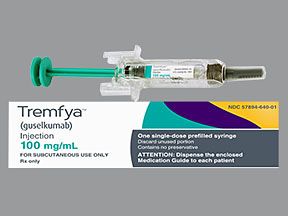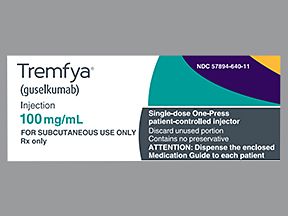If you have plaque psoriasis or psoriatic arthritis, your doctor might suggest Tremfya (guselkumab) as a treatment option.
Tremfya is a prescription medication that’s used to treat the following in adults:
- moderate to severe plaque psoriasis
- psoriatic arthritis
Tremfya is a liquid solution that is injected under your skin. It belongs to a group of medications called interleukin-23 blockers.
Tremfya works by decreasing your symptoms of plaque psoriasis or psoriatic arthritis.
This article describes the dosage of Tremfya, including its forms, strength, and how to use the drug. To learn more about Tremfya, see this in-depth article.
Note: This article covers Tremfya’s typical dosage, which is provided by the drug’s manufacturer. But when using Tremfya, always take the dosage that your doctor prescribes.
Your dosage of Tremfya may depend on:
- the condition that you’re using Tremfya to treat
- other medications that you’re taking
Your doctor will recommend the best dose for you based on these factors.
Below are details about Tremfya’s forms, strength, and typical dosage.
What are the forms of Tremfya?
Tremfya is a drug that you inject under your skin. It comes as a prefilled syringe and a device called a One-Press injector. Each syringe and injector contains a single dose of Tremfya.
If you have questions about Tremfya’s forms and which one may be right for you, talk with your doctor or pharmacist.
What strength does Tremfya come in?
Tremfya comes in a strength of 100 milligrams (mg) per milliliter of solution.
What is the typical dosage of Tremfya?
The information below describes the dosage that is commonly used or recommended. But be sure to take the dosage your doctor prescribes for you. Your doctor will determine the best dosage to fit your needs.
Your doctor may adjust your dosage over time to reach the right amount for you. Your doctor will ultimately prescribe the smallest dosage that provides the desired effect.
Dosage for moderate to severe plaque psoriasis
When you start using Tremfya to treat plaque psoriasis, your doctor will discuss a dosing schedule with you.
You’ll likely begin treatment with a loading dose of Tremfya. A loading dose involves taking either a higher dose than usual or more frequent doses of medication at the start of treatment. This way, the medication can start working more quickly.
For plaque psoriasis, your starter dose will likely be 100 mg. After 4 weeks, you’ll get another 100 mg of Tremfya to complete your loading dose.
After your loading dose, you’ll continue treatment with what is referred to as maintenance dosing. For Tremfya, this is one 100-mg injection every 8 weeks.
Below is a Tremfya dosing chart for treating plaque psoriasis.
| Dose | Week |
| 100 mg | week 0 |
| 100 mg | week 4 |
| 100 mg | every 8 weeks |
Dosage for psoriatic arthritis
The dosage for psoriatic arthritis is the same as it is for moderate to severe plaque psoriasis (see the section just above).
For treating psoriatic arthritis, you may take Tremfya alone or with certain other medications. These medications are called disease-modifying antirheumatic drugs (DMARDs). Your dosage of Tremfya will likely be the same regardless of whether you take it with a DMARD.
Is Tremfya used long term?
Yes, Tremfya is typically used as a long-term treatment. If you and your doctor determine that Tremfya is safe and effective for you, it’s likely that you’ll use it long term.
Your dose of Tremfya will typically be 100 milligrams. When you receive an injection will depend on whether you’re taking a loading dose or maintenance dose.
Be sure to tell your doctor about any other medical conditions that you have and any other medications that you take. It’s possible that your doctor may have to adjust the dosage of your other medications while you’re using Tremfya.
Tremfya is a solution that you inject under your skin. You shouldn’t inject it into a muscle or vein.
A healthcare professional may train you or your caregiver to give Tremfya injections at home. This means that you won’t have to visit your doctor’s office whenever it’s time for your next dose. Don’t try to inject Tremfya before being trained by a healthcare professional.
Tremfya comes as a prefilled syringe and as a device called a One-Press injector. Each syringe or injector contains one dose of Tremfya.
Once you inject the medication, you should dispose of the syringe or injector in a sharps container or
You should store Tremfya in your refrigerator. Take Tremfya out of the refrigerator 30 minutes before your injection to let it warm to room temperature. Avoid warming the drug in any other way, such as using a microwave or holding it in your hands.
Where to inject Tremfya
It’s recommended that you inject Tremfya into the skin at the front of your thighs. You can also inject Tremfya into your lower stomach, at least 2 inches away from your belly button.
If someone else is giving you Tremfya, they can inject it into the back of your upper arms.
You shouldn’t inject Tremfya into skin that’s bruised, red, discolored, hard, or scaly. You should also avoid injecting it into any skin affected by psoriasis.
For step-by-step directions on how to use Tremfya, see the manufacturer’s instructions for use. Talk with your doctor or pharmacist if you still have questions about how to use Tremfya.
If you miss your dose of Tremfya, take it as soon as you remember. You can continue with your next dose at your regularly scheduled time.
If you need help remembering to take your dose of Tremfya on time, try using a medication reminder. This can include setting an alarm, downloading a reminder app, or setting a timer on your phone. A kitchen timer can work, too.
If you have any questions about when to take your next dose of Tremfya, talk with your doctor or pharmacist.
Don’t use more Tremfya than your doctor prescribes. Using more than this can lead to serious side effects.
What to do in case you use too much Tremfya
Call your doctor right away if you think you’ve used too much Tremfya. You can also call 800-222-1222 to reach the American Association of Poison Control Centers, or use its online resource. But if you have severe symptoms, call 911 (or your local emergency number) immediately or go to the nearest emergency room.
The sections above describe the typical dosage provided by the drug manufacturer. If your doctor recommends Tremfya for you, they’ll prescribe the dosage that’s right for you.
Remember, you shouldn’t change your dosage of Tremfya without your doctor’s approval. Only use Tremfya exactly as prescribed. Talk with your doctor if you have questions or concerns about your current dosage.
Here are some examples of questions you may want to ask your doctor:
- Will my dosage of Tremfya be different based on the other medications that I take?
- If I become pregnant while taking Tremfya, will my dosage change?
- Will a change in my dosage of Tremfya cause a change in side effects that I’m experiencing?
- Should I take other medications along with my dosage of Tremfya to treat my condition?
For tips on managing plaque psoriasis as well as news on treatment options, subscribe to Healthline’s online newsletter.
Q:
If Tremfya isn’t working well for me, can my dose be increased, or can I inject Tremfya more often?
Anonymous patientA:
It’s unlikely. Tremfya only comes in one strength: 100 milligrams. Its dosing schedule is the same for both conditions it treats, plaque psoriasis and psoriatic arthritis.
If Tremfya isn’t working to treat your symptoms, you should talk with your doctor. They’ll likely suggest trying a different medication.
Dena Westphalen, PharmDAnswers represent the opinions of our medical experts. All content is strictly informational and should not be considered medical advice.Disclaimer: Healthline has made every effort to make certain that all information is factually correct, comprehensive, and up to date. However, this article should not be used as a substitute for the knowledge and expertise of a licensed healthcare professional. You should always consult your doctor or another healthcare professional before taking any medication. The drug information contained herein is subject to change and is not intended to cover all possible uses, directions, precautions, warnings, drug interactions, allergic reactions, or adverse effects. The absence of warnings or other information for a given drug does not indicate that the drug or drug combination is safe, effective, or appropriate for all patients or all specific uses.











